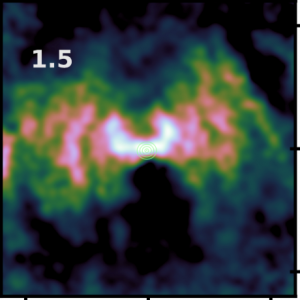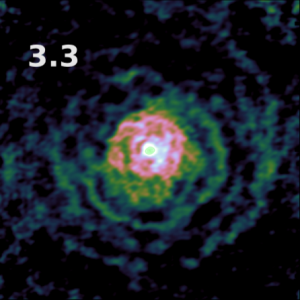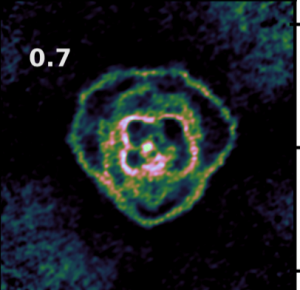A joint team of astronomers including a member of HKU’s Laboratory for Space Research, captured stellar winds in unprecedented detail
A group of astronomers led by the University KU Leuven, Belgium and including Professor Albert Zijlstra, a member of Laboratory for Space Research (LSR), the University of Hong Kong (HKU), have captured the first ever detailed images of unusual stellar winds which surround dying stars. The extraordinary images show mesmerising shapes which solve a century-long mystery about the death of stars like the Sun. Contrary to common consensus, the team found that stellar winds are not spherical but have a shape similar to that of planetary nebulae. The team concludes that interaction with an accompanying star or exoplanet shapes both the stellar winds and planetary nebulae. The findings were published in Science.
The Sun at the end of its life will eject much of its mass into space, in a stellar wind of catastrophic proportions with the final envelope ejection forming a “so-called” planetary nebula. Planetary nebulae show an extraordinary variety of colourful shapes which have been studied by scientists for more than a century. Nevertheless, the origin of these shapes have remained a mystery.
The new findings, published in Science, showed the nebulae all seem to have a certain symmetry, but are almost never round. The images were obtained at the ALMA Regional Centre in Manchester, and five Manchester astronomers were closely involved in the project.
Professor Albert Zijlstra, a member of HKU LSR and a senior author on the paper said: “These recent images are about the stars like the Sun that reach the end of their lives. Nine out of ten stars will form a planetary nebula at that time. The origin of the shapes of the planetary nebulae has never been clear. We did not see strong asymmetries in most stars undergoing the wind. It seemed as if the shapes only formed after the winds had ceased. Our new observations finally resolve this mystery. The winds become aspherical because it interacts with a companion star or nearby planet. The shapes we now see have remarkable similarity to those seen in the subsequent planetary nebula. We can now even predict the shape of the planetary nebula of the future Sun.”
Dying stars swell and cool to eventually become red giants. They produce stellar winds, flows of particles that the star expels, which causes them to lose mass. The Sun will lose as much as half its total mass at that time, 5 billion years from now. Because detailed observations were lacking, astronomers have always assumed that these winds were spherical, like the stars they surround. As the star evolves further, it heats up again and the stellar radiation causes the expanding ejected layers of stellar material to glow, forming a planetary nebula.
“The Sun – which will ultimately become a red giant – is as round as a billiard ball, so we wondered: how can such a star produce all these different shapes?” says corresponding author Leen Decin (KU Leuven).
The team observed stellar winds around cool red giant stars with the ALMA Observatory in Chile, the largest radio telescope in the world. For the first time ever, they gathered a large, detailed collection of observations, each of them made using the exact same method. This was crucial to be able to directly compare the data and exclude biases.
The astronomers could even identify different categories of shapes. Some stellar winds were disk-shaped, others contained spirals, and in a third group, we identified cones. Which showed a clear indication that the shapes were not created randomly.
The team realised that other, low-mass stars or even heavy planets in the vicinity of the dying star were causing the different patterns. These companions are too small and dim to detect directly. “Just like how a spoon that you stir in a cup of coffee with some milk can create a spiral pattern, the companion sucks material towards it as it revolves around the star and shapes the stellar wind,” Decin explains.
The team put this theory into models, and indeed: the shape of the stellar winds can be explained by the companions that surround them, and the rate at which the cool evolved star is losing its mass due to the stellar wind is an important parameter. All of the new observations can be explained by the fact that the stars have a companion.
Up until now, calculations about the evolution of stars were based on the assumption that ageing Sun-like stars have stellar winds that are spherical. Since the complexity of stellar winds was not accounted for in the past, any previous mass-loss rate estimate of old stars could be wrong by up to a factor of 10. The team is now doing further research to see how this might impact calculations of other crucial characteristics of stellar and galactic evolution.The study also helps to envision what the Sun might look like when it dies in 7,000 million years. Jupiter or even Saturn – because they have such a big mass – are going to influence whether the Sun spends its last millennia at the heart of a spiral, a butterfly, or any of the other entrancing shapes we see in planetary nebulae today. The team calculates now that a weak spiral will form in the stellar wind of the old dying Sun.
Professor Quentin Parker, director of the LSR said: “Professor Albert Zijsltra, is a HKU Hung Hing Ying distinguished visiting professor from the University of Manchester and is a key member of the LSR and a regular long-term LSR visitor. He is very close collaborator and a world authority on AGB stars. Hence we are justly very proud of his contributions to this important paper and his use of our affiliation.”
Journal article
The study “(Sub-)stellar companions shape the winds of evolved stars” by Leen Decin et al. was published in Science and can be requested from the authors.
Image download: https://www.scifac.hku.hk/press



Figure 1. From left to right: images of the stars p1 Gru, W Aql and R Aql. The observations were taken with the ALMA telescope in the Atacama desert, Chile. The images were made at the ALMA Regional Centre of the Jodrell Bank Centre for Astrophysics, The University of Manchester
For media enquiries, please contact Casey To, External Relations Officer of HKU Faculty of Science (tel: 3917 4948; email: caseyto@hku.hk / Cindy Chan, Assistant Director of Communications of HKU Faculty of Science (tel: 3917 5286; email: cindycst@hku.hk) or Thomas G. Kaye of the HKU Laboratory for Space Research (email: tom@tomkaye.com).

